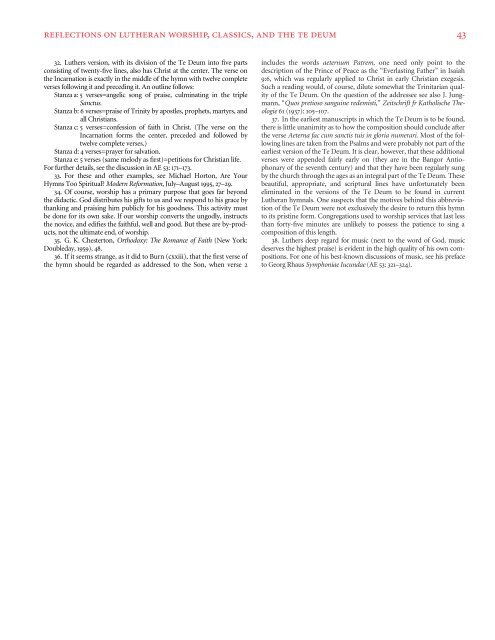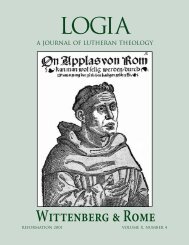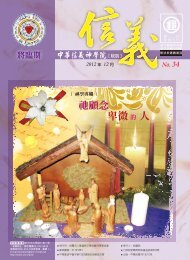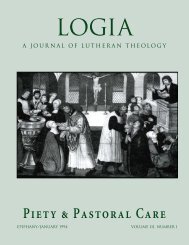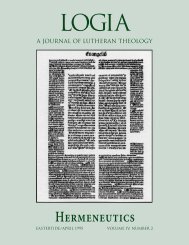05-4 Theology of the..
05-4 Theology of the..
05-4 Theology of the..
You also want an ePaper? Increase the reach of your titles
YUMPU automatically turns print PDFs into web optimized ePapers that Google loves.
REFLECTIONS ON LUTHERAN WORSHIP, CLASSICS, AND THE TE DEUM 43<br />
32. Lu<strong>the</strong>rs version, with its division <strong>of</strong> <strong>the</strong> Te Deum into five parts<br />
consisting <strong>of</strong> twenty-five lines, also has Christ at <strong>the</strong> center. The verse on<br />
<strong>the</strong> Incarnation is exactly in <strong>the</strong> middle <strong>of</strong> <strong>the</strong> hymn with twelve complete<br />
verses following it and preceding it. An outline follows:<br />
Stanza a: 5 verses=angelic song <strong>of</strong> praise, culminating in <strong>the</strong> triple<br />
Sanctus.<br />
Stanza b: 6 verses=praise <strong>of</strong> Trinity by apostles, prophets, martyrs, and<br />
all Christians.<br />
Stanza c: 5 verses=confession <strong>of</strong> faith in Christ. (The verse on <strong>the</strong><br />
Incarnation forms <strong>the</strong> center, preceded and followed by<br />
twelve complete verses.)<br />
Stanza d: 4 verses=prayer for salvation.<br />
Stanza e: 5 verses (same melody as first)=petitions for Christian life.<br />
For fur<strong>the</strong>r details, see <strong>the</strong> discussion in AE 53: 171–173.<br />
33. For <strong>the</strong>se and o<strong>the</strong>r examples, see Michael Horton, Are Your<br />
Hymns Too Spiritual Modern Reformation, July–August 1995, 27–29.<br />
34. Of course, worship has a primary purpose that goes far beyond<br />
<strong>the</strong> didactic. God distributes his gifts to us and we respond to his grace by<br />
thanking and praising him publicly for his goodness. This activity must<br />
be done for its own sake. If our worship converts <strong>the</strong> ungodly, instructs<br />
<strong>the</strong> novice, and edifies <strong>the</strong> faithful, well and good. But <strong>the</strong>se are by-products,<br />
not <strong>the</strong> ultimate end, <strong>of</strong> worship.<br />
35. G. K. Chesterton, Orthodoxy: The Romance <strong>of</strong> Faith (New York:<br />
Doubleday, 1959), 48.<br />
36. If it seems strange, as it did to Burn (cxxiii), that <strong>the</strong> first verse <strong>of</strong><br />
<strong>the</strong> hymn should be regarded as addressed to <strong>the</strong> Son, when verse 2<br />
includes <strong>the</strong> words aeternum Patrem, one need only point to <strong>the</strong><br />
description <strong>of</strong> <strong>the</strong> Prince <strong>of</strong> Peace as <strong>the</strong> “Everlasting Fa<strong>the</strong>r” in Isaiah<br />
9:6, which was regularly applied to Christ in early Christian exegesis.<br />
Such a reading would, <strong>of</strong> course, dilute somewhat <strong>the</strong> Trinitarian quality<br />
<strong>of</strong> <strong>the</strong> Te Deum. On <strong>the</strong> question <strong>of</strong> <strong>the</strong> addressee see also J. Jungmann,<br />
“Quos pretioso sanguine redemisti,” Zeitschrift fr Katholische Theologie<br />
61 (1937): 1<strong>05</strong>–107.<br />
37. In <strong>the</strong> earliest manuscripts in which <strong>the</strong> Te Deum is to be found,<br />
<strong>the</strong>re is little unanimity as to how <strong>the</strong> composition should conclude after<br />
<strong>the</strong> verse Aeterna fac cum sanctis tuis in gloria numerari. Most <strong>of</strong> <strong>the</strong> following<br />
lines are taken from <strong>the</strong> Psalms and were probably not part <strong>of</strong> <strong>the</strong><br />
earliest version <strong>of</strong> <strong>the</strong> Te Deum. It is clear, however, that <strong>the</strong>se additional<br />
verses were appended fairly early on (<strong>the</strong>y are in <strong>the</strong> Bangor Antiophonary<br />
<strong>of</strong> <strong>the</strong> seventh century) and that <strong>the</strong>y have been regularly sung<br />
by <strong>the</strong> church through <strong>the</strong> ages as an integral part <strong>of</strong> <strong>the</strong> Te Deum. These<br />
beautiful, appropriate, and scriptural lines have unfortunately been<br />
eliminated in <strong>the</strong> versions <strong>of</strong> <strong>the</strong> Te Deum to be found in current<br />
Lu<strong>the</strong>ran hymnals. One suspects that <strong>the</strong> motives behind this abbreviation<br />
<strong>of</strong> <strong>the</strong> Te Deum were not exclusively <strong>the</strong> desire to return this hymn<br />
to its pristine form. Congregations used to worship services that last less<br />
than forty-five minutes are unlikely to possess <strong>the</strong> patience to sing a<br />
composition <strong>of</strong> this length.<br />
38. Lu<strong>the</strong>rs deep regard for music (next to <strong>the</strong> word <strong>of</strong> God, music<br />
deserves <strong>the</strong> highest praise) is evident in <strong>the</strong> high quality <strong>of</strong> his own compositions.<br />
For one <strong>of</strong> his best-known discussions <strong>of</strong> music, see his preface<br />
to Georg Rhaus Symphoniae Iucundae (AE 53: 321–324).


